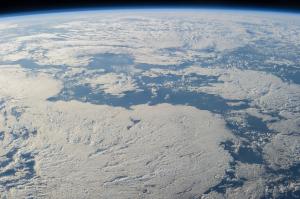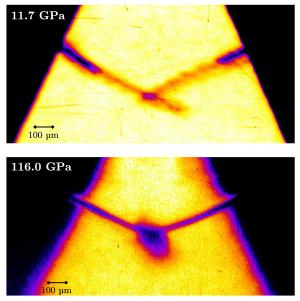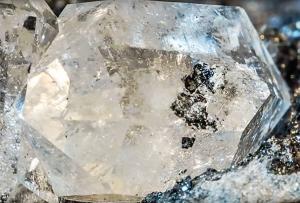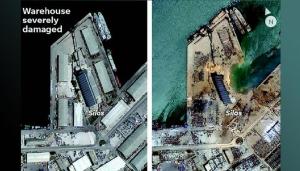LAB REPORT
Science and Technology Making Headlines
Oct. 8, 2021


The Earth reflects light from the sun in this photograph taken by an Expedition 40 crew member on the International Space Station. New research suggests the Earth is reflecting less light due to climate change. Image courtesy of NASA.
A cloudy bounce back effect
Scientists now know that about a third of the sunlight that strikes the Earth gets beamed back out to space.
Some of it is reflected by land, and some by oceans and the shining snow and ice at the poles. But the biggest source of earthshine is probably the planet’s fluffy, white clouds. Scientists are using telescopes and satellites to monitor the Earth’s reflectance, referred to by scientists as its “albedo,” over time. And they’ve just made a startling discovery.
Over the last few years, the planet has grown suddenly dimmer. Climate models indicate that low-level tropical clouds will probably decline as the planet gets hotter. As a result, the planet will absorb more solar radiation. It’s a process that could actually speed up the rate of future global warming, scientists say — a kind of self-perpetuating feedback cycle.
In the future, climate change is likely to have a bigger effect on the planet’s cloud cover. Multiple recent studies have concluded that future warming is likely to inhibit the formation of reflective, low-level clouds. And it’s likely to affect other types of cloud cover in ways that will amplify future climate change.
“The future changes we expect all point to reduced low-level clouds,” said Mark Zelinka, a climate scientist and cloud expert at Lawrence Livermore National Laboratory.


The LLNL “Microbes Persist” project was just awarded $15 million by the Department of Energy. Image by Victor Leshyk/Center for Ecosystem Science and Society, Northern Arizona University.
A matter of life and death
Do dead microbes control the future of Earth’s climate? A team of researchers led by Lawrence Livermore National Laboratory (LLNL) suspects they might. Using new tools, the team can see which soil organisms are thriving and which are dying in California’s changing climate — and what happens to carbon in their cell biomass when they do.
The seven-institution team has just been awarded $15 million by the Department of Energy Biological and Environmental Research Genomic Sciences Program to investigate how the life and death of soil microbes may author the destiny of most of the world’s soil carbon.
“Our fate is bound up with soil carbon, and its fate is bound up with these intricate microbial communities, whose individual capabilities and interactions we are only beginning to understand,” said Jennifer Pett-Ridge, the lead investigator and Environmental Isotope Systems group leader at LLNL. “Using new tools, some of which this team developed, we are asking: how can understanding the microbial lives unfolding in soil tell us about the future of carbon?”


The graphic depicts sequences of radiographs of interacting planar tin ejecta microjets.
When you’re a jet
Lawrence Livermore scientists have successfully imaged the collision of a pair of micrometer-wide jets made of tin particles.
Shine a high-powered laser at one side of a metal foil and a jet of particles will fly out of the other. The LLNL researchers have imaged and tracked the particles in these jets to measure, for example, how the type of metal affects the sizes and velocities of the particles.
LLNL’s Alison Saunders and her colleagues have captured images of two of these jets colliding. Being able to obtain such images opens up many new avenues for experiments, Saunders said, as researchers will be able to study interactions between jets in more detail. Similar interactions occur between particles during planetary formation and other high-energy processes.

Ice VII was found lurking in diamonds mined from Earth's mantle.
Breaking the ice mold
New research involving Lawrence Livermore scientists shows that water can remain liquid in a metastable state when transitioning from liquid to a dense form of ice at higher pressures than previously measured.
Water at extreme conditions has attracted recent attention because of its complex phase diagram, including superionic ice phases having exotic properties that exist at high pressures and densities. To date, 20 unique crystalline ice phases have been found naturally on Earth or in the laboratory. Water also exhibits bizarre metastable phenomena when compressed or cooled very rapidly, which have attracted interest from physicists worldwide for many years.
“If the water is compressed very rapidly, it will remain liquid in a metastable state until finally crystallizing into ice VII at a higher pressure than expected,” said Michelle Marshall, a research scientist at the Laboratory for Laser Energetics at the University of Rochester and a former LLNL postdoc.
Ice VII is the stable polymorph of water at room temperature and at pressures exceeding ∼2 GPa (more than 19,000 atmospheres). Recently, ice VII was found naturally on Earth for the first time as inclusions in diamonds sourced deep within the mantle. It may exist inside Jupiter’s icy moons and in water worlds beyond our solar system.


Before (left) and after (right) of the crater caused by the Beirut explosion on Aug. 4, 2020.
Just how big was the Beirut explosion?
On Aug. 4, 2020, one of the largest non-nuclear explosions in history pulverized a Beirut port and damaged more than half the city. The explosion resulted from the detonation of tons of ammonium nitrate, a combustible chemical compound commonly used in agriculture as a high-nitrate fertilizer, but which also can be used to manufacture explosives.
Since that time, the explosive yield estimates varied widely, and in some cases, were inconsistent with what would be expected based on the amount of ammonium nitrate stored at the Beirut harbor. In addition, the crater size, seismic magnitude and mushroom cloud height seemed to be inconsistent.
Lawrence Livermore physicist Peter Goldstein has studied how water saturation of the explosive, ground and possibly water and debris from the near-source environment can help reconcile differences in the yield estimates. Official records indicate that roughly 2.7 kilotons of explosive material were stored at the Beirut harbor warehouse where the explosion occurred. The detonation of these materials resulted in a large crater and seismic measurements suggested it was possible that the yield was at least a few kilotons and possibly much greater. However, there were other estimates that suggested the yield was quite a bit smaller, possibly as little as half a kiloton.
Goldstein's research analyzes the crater dimensions, seismic magnitude estimates and the cloud height of the explosion and shows that all the data are consistent with a yield of around a kiloton when water/saturation is accounted for.





